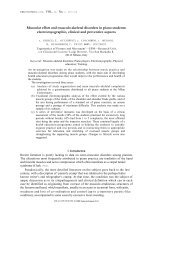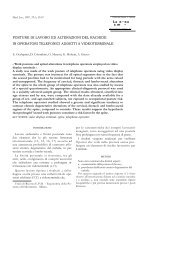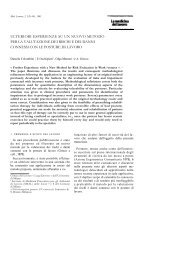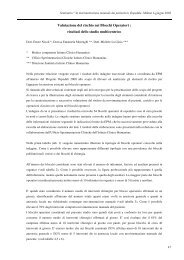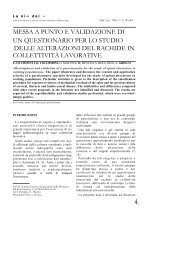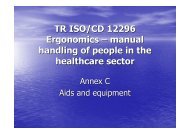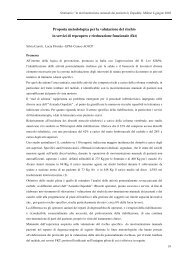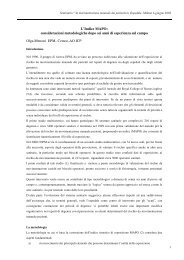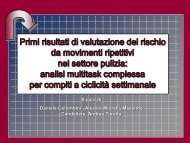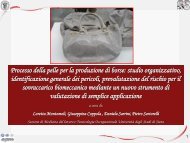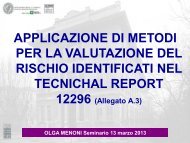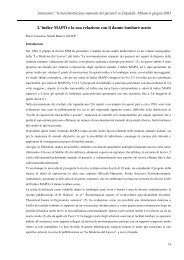Ocra method a new procedure for analysing multiple repetitive tasks
Ocra method: a new procedure for analysing multiple ... - epm
Ocra method: a new procedure for analysing multiple ... - epm
Create successful ePaper yourself
Turn your PDF publications into a flip-book with our unique Google optimized e-Paper software.
Just to allow assessment of exposure level, an analyticalmodel was set up essentially recalling the previous one butallowing a more accurate daily diversification.Description of task periodicity and duration along thedifferent weekdaysAlso in this case as well, the first step is to identify theworkers’ homogeneous group carrying out the same <strong>tasks</strong> overthe week: which and how many workers are involved andwhich <strong>tasks</strong> are they going to carry out.The input model <strong>for</strong> in<strong>for</strong>mation collection on duration ofdifferent <strong>tasks</strong> in the work-shift is only ANALYTICAL. It isnot difficult to obtain more accurate exposure data (over theday) such as detail of minutes worked <strong>for</strong> each task developedduring a work-shift. If there are organizational discrepanciesin the different weekdays, they are to be accurately described(Table 15).This table clearly shows that organizational in<strong>for</strong>mationneeded are aimed at obtaining the REPETITIVE WORK NETTIME as a whole and <strong>for</strong> each developed <strong>repetitive</strong> task. Thiswill allow to obtain both their intrinsic % distribution anddistribution weighted over the above mentioned timesconstants (see Table 5).OCRA checklist <strong>for</strong> assessment of risk intrinsic level.Intrinsic risk index is assessed <strong>for</strong> identified <strong>tasks</strong> usingOCRA checklist as already described <strong>for</strong> yearly cycle <strong>tasks</strong>.Exposure will be calculated <strong>for</strong> each working day in theweek.When all week days were similar, one day assessmentwould be sufficient to represent weekly exposure; but whendaily variation are present in <strong>tasks</strong> distribution and shiftduration, <strong>for</strong> each working day we will have to focus on:-shift duration-total net duration of <strong>repetitive</strong> works- duration of each <strong>repetitive</strong> work-duration and distribution of breaks.These data will allow to recalculate <strong>for</strong> each task the OCRAchecklist, this time amended <strong>for</strong> the actual net duration ofshift <strong>repetitive</strong> works and the actual distribution of recoverytimes day by day.NON REPETITIVE WORKING TASKSDISTRIBUTION OF SHIFTS OVER THE WEEK BY HOMOGENEOUSGROUPMON TUE WED THUR FRI SAT SUNShift duration (in minutes) 200 300 350 400 400 480x 5,0 5,0 5,0 5,0 5,0 5,0y 5,0z 10,0 10,0 10,0Total duration of breaks by shift(min.)0,0 10,0 15,0 20,0 25,0 30,0Net duration of <strong>repetitive</strong> <strong>tasks</strong> 195 275 330 365 360 440 0 1965 4,1 100,0% 89,3%REPETITIVE WORKING TASKS MON TUE WED THUR FRI SAT SUNTOTAL OFWORKEDMINUTESTOTALDAYS% ON TOTAL OFHOURS WORKED AWEEK% EXTIMATED ONTIME CONSTANTH 195 100 100 100 440 935 1,9 47,6% 43%I 100 90 190 0,4 9,7% 9%L 75 130 100 305 0,6 15,5% 14%M 100 365 70 535 1,1 27,2% 24%Table 15 – Description of breaks and <strong>repetitive</strong> and non-<strong>repetitive</strong> <strong>tasks</strong> carried out in the different weekdays to obtain theREPETITIVE WORK NET TIME per each worked day.Calculation models <strong>for</strong> weekly exposure assessmentIn view of achieving the final weekly exposure values,stage calculation is proposed: assessment of daily exposureand subsequent collection of results <strong>for</strong> assessing weeklyexposure.a) Assessment of daily exposureLike <strong>for</strong> daily turnover in <strong>repetitive</strong> <strong>tasks</strong>, 2 events mayoccur: rotation takes place at least every hour; rotation takesplace less than once per hour.- When rotation among <strong>repetitive</strong> <strong>tasks</strong> occurs at least everyhour, to calculate the exposure value, the time-weightedaverage of final intrinsic risk indices is calculated usingequation (1):-When rotation occurs less than once per hour, the weightedaverage the mathematical model using the “worst workingsituation” is to be used: Checklist OCRA Multitask Complexequation (2) should be used.These two representative exposure evaluation model willallow to calculate the risk level <strong>for</strong> each day of the week: thefirst representing exposure to <strong>tasks</strong> with at least an hourlyrotation and the second represents a condition with rotationexceeding one hour (Table 17).Once the values per working day have been obtained, twoassessment paths have to be followed to evaluate the finalweek exposure risk index :- rotation among <strong>tasks</strong> is any day of the week at leasthourly. The derived data, representative of each working8




